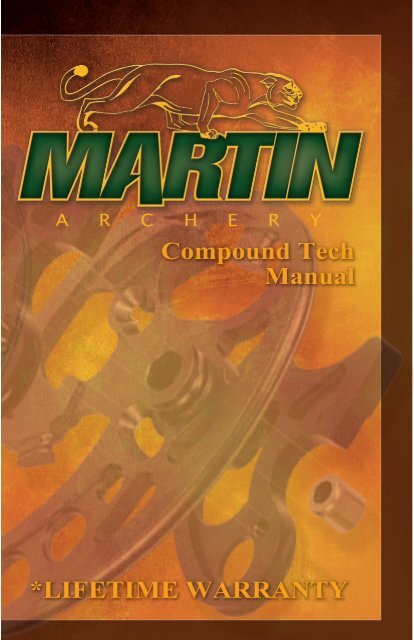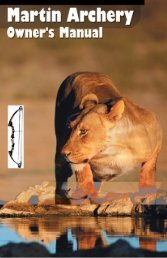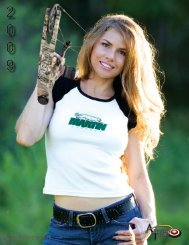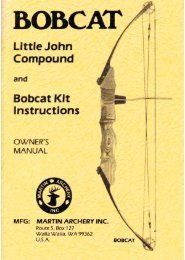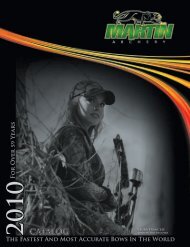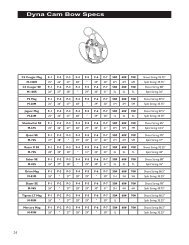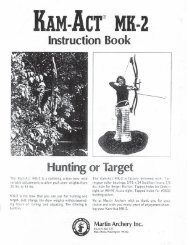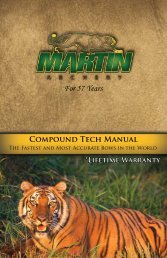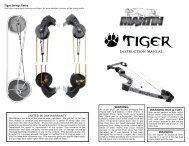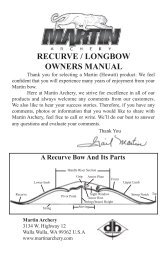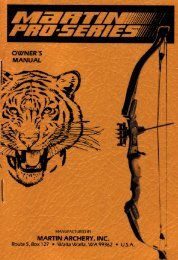Create successful ePaper yourself
Turn your PDF publications into a flip-book with our unique Google optimized e-Paper software.
Welcome to the <strong>Martin</strong> <strong>Archery</strong> Family. We are confident that you will<br />
experience many years of enjoyment from your new <strong>Martin</strong> bow. Each bow that<br />
leaves our door is handmade one at a time as they have been for over fifty years.<br />
<strong>Martin</strong> <strong>Archery</strong> remains a family owned and operated business. We take great<br />
pride in every product we produce and we strive to offer you the most complete<br />
line of professional accessories available.<br />
We welcome any comments you may have about our products. We also<br />
like to hear stories of your successes while using our products. If you have any<br />
comments, photos, or information you would like to share with us, please call<br />
or write. We will do our best to answer any questions you may have.<br />
To better serve you, we have the most complete archery manufacturers<br />
Web page on the World Wide Web. Our home page includes a hot link directly<br />
to our E-mail box so you can keep in touch with us.<br />
Our Web page is located at: www.martinarchery.com<br />
Our E-mail address is: info@martinarchery.com<br />
Thank You,<br />
Gail <strong>Martin</strong><br />
Founder and President<br />
<strong>Martin</strong> <strong>Archery</strong> Inc.
<strong>TABLE</strong> <strong>OF</strong> <strong>CONTENTS</strong><br />
PARTS <strong>OF</strong> THE BOW ................................................................................ 1<br />
BASIC SETUP<br />
• Cable Guard Installation................................................................. 2<br />
• Changing Draw Weight................................................................... 2<br />
• Setting Tiller.................................................................................... 3<br />
• Setting Arrow Rest Position............................................................ 3<br />
• Setting Nock Point.......................................................................... 4<br />
• Replacing Strings............................................................................ 4<br />
• Care and Storage ............................................................................ 4<br />
NITROUS & NITROUS-X CAM SYSTEM........................................... 4<br />
• Parts of the Nitrous System............................................................ 5<br />
• Changing the draw.......................................................................... 5<br />
• Setting the cam timing.................................................................... 6<br />
• Converting to Shoot-Through X System........................................ 7<br />
TRU-ARC CAM SYSTEM..................................................................... 7<br />
• Parts of the Tru-ARC System......................................................... 7<br />
• Changing the draw.......................................................................... 8<br />
• Proper string installation and cam rotation..................................... 8<br />
DYNA SINGLE CAM............................................................................ 9<br />
• Setting Draw Length....................................................................... 9<br />
• String configuration........................................................................ 10<br />
FINE TUNING YOUR COMPOUND BOW<br />
• Bare Shaft Planing Test................................................................... 11<br />
• Paper Tuning................................................................................... 13<br />
SUPER FINE TUNING<br />
• Short Range Group Tuning............................................................. 16<br />
• Flight Tuning Broadheads............................................................... 17<br />
MARTIN WARRANTY .............................................................................. 18
OWNER'S RECORD<br />
Bow Model:_________________________________<br />
Date Purchased:_________________________________<br />
Cam Style:_________________________________<br />
Draw Weight:_________________________________<br />
Draw Length:_________________________________<br />
String Length:_________________________________<br />
Cable Length:_________________________________<br />
Control String Length:_________________________________<br />
Tru- Arc Bows only<br />
Purchased From:_________________________________<br />
NOTICE:<br />
Staple your sales receipt here<br />
Proof of purchase date is needed<br />
should you ever require warranty work
PARTS <strong>OF</strong> THE BOW<br />
Axle<br />
Upper Limb<br />
Split String<br />
Shooting String<br />
Limb Bolt<br />
Riser<br />
Barrel Nut<br />
Quiver Mounts<br />
Cable Guard<br />
Grip<br />
Lock Mount<br />
Rest Mounting<br />
System<br />
Stabilizer Insert<br />
Limb Pocket<br />
Lower Limb<br />
Cam<br />
Slayr with Tru-Arc Cam System<br />
1
BASIC SETUP<br />
Your new <strong>Martin</strong> bow takes little setup to get started shooting. Please read and<br />
familiarize yourself with these starting procedures before shooting. Many of these<br />
procedures may have been completed by your authorized <strong>Martin</strong> dealer. After completing<br />
these simple steps, you will be more accurate and will have greater success<br />
from the start. A careful and thorough initial setup will make the tuning process<br />
much easier.<br />
CABLE GUARD INSTALLATION<br />
Insert cable guard into the rear 3/8”<br />
hole in the riser. Put the lock screw<br />
through the NON-threaded half of the<br />
Cam Lock and place it in the sight window<br />
side of the riser. Put the threaded<br />
half of the Cam Lock in the back side<br />
of the riser and screw in the screw, but<br />
do not tighten. The cable guard rod<br />
should be rotated toward the grip to<br />
provide adequate fletching clearance.<br />
Caution should be taken against overrotating<br />
the rod as excessive clearance<br />
can cause unnecessary pressures on<br />
the limb tips and axle bearings. Once<br />
optimum angle is achieved fully tighten<br />
the screw, but do not over tighten.<br />
Cam Lock<br />
Screw<br />
Non-threaded<br />
3/8"Cable<br />
Guard Hole<br />
Cam Lock<br />
Cable<br />
Guard<br />
Threaded<br />
CHANGING DRAW WEIGHT<br />
<strong>Martin</strong> bows have a fifteen pound draw weight range. Using the 3/16” allen wrench<br />
supplied with each bow, you will turn the limb bolts clockwise to add weight and turn<br />
counter clockwise to reduce weight. One complete turn on each limb bolt provides<br />
about 3 pounds of adjustment.<br />
TIP: Mark a line on each limb bolt in white-out or white paint marker to make it easier<br />
to keep track of how far you are turning each bolt.<br />
NOTE: Do not shoot your bow with the limb bolts more than 5 turns out from the<br />
riser.<br />
2
SETTING TILLER<br />
Taking a tiller measurement allows you to check the<br />
relative tension setting of the upper and lower limbs. After<br />
setting the draw weight on your bow, you will need to<br />
check the tiller measurement to make sure that you have<br />
adjusted your limbs evenly. On all <strong>Martin</strong> compound bows,<br />
“0” or even tiller will shoot perfectly. However, the tiller<br />
measurement can vary up to 1/4” closer at the bottom.<br />
There is no set measurement that provides peak performance<br />
for every shooter. To measure your tiller, simply<br />
measure from the limb pockets to the string on both ends<br />
of the bow. Some shooters find that different tiller measurements<br />
from "0" work better for them. It will not hurt your<br />
bow in any way if you experiment with tiller.<br />
Note: Your Peep Sight position and your nock point position can<br />
change when you turn one limb bolt. Take detailed measurements<br />
and be sure that your nock and peep are correct each<br />
time you turn your limb bolts.<br />
SETTING DRAW LENGTH<br />
All <strong>Martin</strong> Bows are adjustable with the use of modules.<br />
However, you will need to refer to the section that covers<br />
your specific cam style for instructions on adjusting draw<br />
length.<br />
SETTING ARROW REST POSITION<br />
After your arrow rest is installed,<br />
you will need to set it at a good starting<br />
point to begin tuning. The easiest<br />
way to do this is to visually align the<br />
bowstring in the center of the grip section.<br />
If you are shooting your bow with<br />
a release aid, the prongs or blade of<br />
your shoot-through rest will need to be<br />
centered with the bow string. During<br />
tuning, your arrow rest may need to be<br />
moved in or out from it’s centered location.<br />
This is normal because different<br />
shooters apply different pressures<br />
to the bow. Finger shooters will need<br />
to position the rest so that the point is<br />
about 1/8” outside the string. This is to<br />
compensate for the horizontal bending<br />
of the arrow upon release. An arrow<br />
rest that provides some side support,<br />
such as a cushion button for the arrow,<br />
is best for finger shooters.<br />
Finger Setting<br />
Release Setting<br />
3
SETTING NOCK POINT<br />
Place a bow square on the string and slide the square down<br />
until it rests on your arrow rest. Then place a moveable nock set<br />
on the string. Using the measuring scale on the bow square, set<br />
the nock set at the proper location on the string. A good starting<br />
point for finger shooting is ¼” high, measuring from the bottom<br />
of the nock set to 90° on the bow string. Start at 1/8” high if you<br />
are using a release aid. If you do not have a bow square, you can<br />
snap an arrow on the string and visually level the arrow. Then<br />
crimp your nock set. In a pinch, this will get you to a good starting<br />
location.<br />
1/2<br />
1/4<br />
90 0<br />
REPLACING THE STRINGS<br />
Should your string need replacing, it is best to go to your <strong>Martin</strong> dealer and have it<br />
expertly done. It is recommended that you replace your string once a year or anytime it<br />
shows wear. Always be sure that the string you replace it with is of the correct length and<br />
material for your bow.<br />
CARE AND STORAGE<br />
When properly cared for, your new <strong>Martin</strong> bow will give you years of<br />
trouble-free service. When your bow is new it will require no lubrication. Over time you<br />
may need to lubricate your cams to guard against friction and noise. Use a dry lubrication<br />
such as Teflon spray powder or graphite powder. You can also use wet lube such as Moly<br />
Lube or Tri-Flow. Do not use WD-40 lubrication.<br />
A good rule of thumb when caring for your bow is to keep it as comfortable as you are.<br />
If it is too hot for you, it is too hot for your bow. If it gets wet, dry it off completely. Periodically<br />
clean your bow with a wet rag and mild soap to remove mud or dust (caution: do<br />
not store until completely dry). Prolonged exposure to extreme heat may cause failure in<br />
your bow limbs and excessive stretch in your harness system. It will not hurt your bow if<br />
it is rained on while shooting, but make sure it is completely dry before storing in a bow<br />
case to guard against rust or corrosion.<br />
CAM SYSTEMS<br />
NITROUS AND NITROUS-X CAMS<br />
Your Nitrous and Nitrous-X Cam System uses a rotating module and one<br />
of 3 base cam sizes (see below). Refer to the spec charts at your dealer or<br />
www.martinarchery.com to see what base you need for your draw.<br />
A Cam<br />
4<br />
B Cam<br />
C Cam
PARTS <strong>OF</strong> THE NITROUS CAM<br />
X-Module<br />
Module<br />
Module<br />
Screws<br />
Speed<br />
Bearing<br />
Base<br />
Cam<br />
CHANGING THE DRAW LENGTH<br />
Your Nitrous Cam may be an X Shoot-<br />
Through system or a standard system, but<br />
the draw is adjusted basically the same. The<br />
threaded module has numbers and dashes on<br />
it that indicate what setting you are on while<br />
you are adjusting it. The dashes signal 1/2"<br />
draw increments. When you are adjusting<br />
the draw make sure that both modules are in<br />
the same setting. To rotate the modules, you<br />
will need to remove the mod screw closest<br />
to the Cable Boss and loosen the module<br />
screw that is closest to the Bearing Boss.<br />
If you are using a Mini Module for short<br />
draws, there is only one screw. Slide the<br />
module to the desired position and replace<br />
and tighten the screws in the appropriate<br />
positions. The modules provide a longer<br />
draw as the module number gets higher.<br />
Bearing<br />
Boss<br />
Cable<br />
Anchor<br />
Shooting<br />
String<br />
Anchor<br />
Mod settings<br />
Cable<br />
Boss<br />
For more options in draw length adjustment see the section called Using Nitrous<br />
Mini Modules on the next page.<br />
5
SETTING THE CAM TIMING<br />
Wheel timing on a two cam bow makes sure that the nock travel through the shot<br />
is straight and level. It is important that your bow is timed well for greatest accuracy.<br />
Setting the timing is very easy, and you will be able to go through this step by step and<br />
set your timing like a pro. First, you will need to draw your bow back to full draw with<br />
Both cable stops<br />
are touching in unison.<br />
It is perfect.<br />
Twist or TIGHTEN<br />
this cable, either from<br />
its loop end or its split<br />
yoke (located at the<br />
opposite end of the<br />
bow.)<br />
The top cable stop is<br />
coming to rest before<br />
the bottom. The top is<br />
out of time with the<br />
bottom. Put a twist in<br />
the cable that is connected<br />
to the top cam.<br />
your release and an arrow.<br />
As you begin to reach<br />
full draw, slow down and<br />
watch the cable stops roll<br />
over to the cable as seen<br />
to the left. You can have<br />
a friend check or you can<br />
see it yourself. It is also<br />
helpful to perform this test<br />
with the bow backed off a<br />
few turns. This will make it<br />
easier to hold while you are<br />
checking the cable stops.<br />
If your cams look like the<br />
ones to the far left, they<br />
are perfectly timed. If one<br />
touches before the other, as<br />
seen on the right, you will<br />
need to twist or TIGHTEN<br />
the cable that is connected<br />
to the cam that stops first.<br />
Relax the bow in a bowpress<br />
before attempting<br />
to make any adjustments.<br />
You can adjust the cam's<br />
rotation using two methods.<br />
You can follow that cam's<br />
cable to its split yoke and<br />
make adjustments there by<br />
removing and twisting the yoke, or you can disconnect the cable from it's peg on the<br />
cam and twist. This will change the cams rotation a little to get it in sync with the other.<br />
Only twist one or two twists at a time. A little twisting goes a long way. Once you get<br />
it really close, you can put a half twist in the cable to get it perfect if needed. Try not to<br />
over complicate this procedure; it is as simple as it sounds.<br />
USING NITROUS MINI-MODULES<br />
In some cases your draw length will be at the shortest end of the cam's draw length<br />
adjustment range. Using a Mini Module will give you two more inches down on any<br />
of the Nitrous Cam bodies, and it will give you better performance in the short draw<br />
lengths. See your local dealer for a set of Mini Modules if you are in the last two draw<br />
length settings. The Mini Module will give you more draw length flexibility.<br />
6
Mounting<br />
Screw Holes<br />
Let-Off<br />
Designation<br />
Notes an X<br />
Module<br />
Countersinks<br />
Let-Off<br />
Designation<br />
Mounting<br />
Screw Hole<br />
Notes an X<br />
Module<br />
Countersink<br />
Standard Modules<br />
Standard Modules use two mounting screws. The X module is noted<br />
with an X on the tail, it can be installed per the instructions below<br />
to make your bow a shoot through system. The (T) on the tail of<br />
the mod notes that it will fit on the top cam (NOTE: left handed<br />
shooters are the opposite.) The module that is labled with a (B)<br />
goes on the Bottom.<br />
MINI MOD<br />
MINI MOD<br />
Mini Modules<br />
Mini Modules use one mounting screw. The Mini Module will<br />
give you an additional 2 inch reduction of draw length on any<br />
Nitrous Cam System. If you are in the last two settings on the<br />
Standard Mod, the Mini Mod will give you more draw length<br />
flexibility and better performance in the shorter draw lengths.<br />
CONVERTING TO THE X- SHOOT THROUGH SYSTEM<br />
The Nitrous-X system eliminates the cable guard and the pressures it creates.<br />
Converting your Nitrous System to the X Shoot-Through System is very easy. All you<br />
need to do is order a conversion kit from your dealer and it will come with X-Modules,<br />
cables, long mod screws, and long axles. Your dealer can easily add the second module<br />
to the top and bottom and then slide in the long axles with the use of a bow press. Install<br />
the 4 cables and presto! You have a Nitrous-X system.<br />
PARTS <strong>OF</strong> THE TRU-ARC CAM SYSTEM<br />
Shooting<br />
String<br />
Mod<br />
Screw<br />
Bottom<br />
Tru-ARC<br />
Bottom<br />
Tru-ARC<br />
Top Tru-<br />
Arc<br />
Top Tru-Arc<br />
Control Track<br />
Top Module<br />
Control<br />
String<br />
Mod Screw<br />
Speed Ball<br />
Bearing<br />
Speed Ball<br />
Bearing<br />
TRU-ARC CAMS<br />
The Tru-ARC is a very unique cam<br />
system. It is technically a Hybrid Cam and<br />
it is a blend of a Dual Cam system and a<br />
Single Cam system. It has the straight and<br />
level nock travel of a Dual Cam and the<br />
timing simplicity of Single Cams. It is a<br />
very simple system to set up and it is very<br />
easy to shoot. See the following guide for<br />
complete set up and tuning of the Tru-Arc<br />
System.<br />
CAUTION: BEFORE<br />
SETTING THE DRAW<br />
LENGTH. You will need to<br />
put your bow in a bow press<br />
and relax the strings and<br />
cables before adjusting the<br />
draw length.<br />
7
CHANGING THE DRAW<br />
Tru-ARC cams are different from any<br />
other cam on the market. The thing that<br />
makes them special is when you move<br />
the modules, they automatically adjust the<br />
rotation of the cams for peak performance<br />
and optimum nock travel condition at each<br />
individual draw length.<br />
Your Tru-ARC cam comes with all the<br />
modules you need to cover all of the available<br />
draw lengths. You have a Long module<br />
marked with an L-(letoff) and a Short<br />
module marked with an S-(letoff). Consult<br />
the module chart at your local dealer or at<br />
www.martinarchery.com to see which mod<br />
you need to fit your specific draw length.<br />
You will need to put your bow in a<br />
bow press and relax the strings and cables<br />
before adjusting the draw length. NOTE:<br />
Back your bow off to the minimum weight<br />
setting before pressing. This will put less<br />
stress on the bow and make your adjustments<br />
easier to accomplish. To move the<br />
modules, you will need to remove or loosen<br />
the mod screws and rotate the mod to the<br />
proper letter. Higher letters give the longer<br />
draw lengths. TIP: for optimum performance,<br />
both modules need to be in the same<br />
setting. However, if you need an additional<br />
1/4" draw adjustment, you can move the<br />
upper module up or down ONE setting<br />
from the actual letter that the bottom is<br />
set. This does compromise performance<br />
slightly, but it is a great way to tweak the<br />
draw that last little bit if needed.<br />
You will need to put your bow in a bow<br />
press and relax the strings and cables<br />
before adjusting the draw length.<br />
PROPER STRING INSTALLATION<br />
AND CAM ROTATION<br />
Refer to the diagram on the right for the<br />
proper string configuration. Proper string<br />
lengths for your model may be found on our<br />
web site or at your local dealer. Your cam<br />
8<br />
Split<br />
String<br />
Shooting<br />
String<br />
Draw<br />
Indicator<br />
Control<br />
String<br />
Draw<br />
Indicator
otation is pre-set at the factory and should not need adjusting, but refer to the position<br />
of the cams to the left. This is the optimum rotation. If it is other than what you see here,<br />
check your string lengths.<br />
DYNA SINGLE CAM<br />
The Dyna System is unique among all other single cam systems. The Dyna<br />
System has modular draw length adjustment, and can be adjusted in half inch adjustments<br />
within each draw length module.<br />
PARTS <strong>OF</strong> THE DYNA SYSTEM<br />
Module<br />
Screw<br />
Speed<br />
Ball<br />
Bearing<br />
Speed<br />
Ball<br />
Bearing<br />
Bottom<br />
Cam<br />
Module<br />
Idler<br />
Wheel<br />
ADJUSTING THE DRAW LENGTH<br />
The Dyna Single Cam System boasts a<br />
revolutionary design and is engineered to<br />
give you peak performance and speed. Using<br />
draw length modules, the draw length can<br />
be adjusted in 1" increments. The modules<br />
can also be used to adjust the let-off. A high<br />
let-off module is marked as F-#. A 65% let<br />
off module is marked with a F-#\. The slash<br />
1<br />
on the end of the size number indicates 65%<br />
let-off. To change the draw length, replace the<br />
module on the cam by removing the screws<br />
that hold it to the cam. NOTE: do not draw<br />
your bow without the module installed. It<br />
will damage your harness. The Dyna module<br />
sizes range from F-1 to F-7. If you would like<br />
to increase the draw length, select a higher<br />
2<br />
3<br />
number. If you would like to decrease the draw length select a lower number. The draw<br />
length can also be adjusted up or down 1/2" using the pegs on the back of the cam. The<br />
#2 peg is the prescribed draw length for each module. The #1 peg is 1/2" longer and the<br />
#3 peg is 1/2" shorter. The draw weight will change one pound, accordingly, when using<br />
the peg adjustment.<br />
9
STRING CONFIGURATION<br />
The string harness on the new Dyna<br />
Cam is installed according to the diagram<br />
below. Your string harness should<br />
be installed by your qualified <strong>Martin</strong><br />
dealer. Pay close attention to how the<br />
Shooting String leaves the cam. Although<br />
cam rotation is not critical, use<br />
this diagram as a loose representation of<br />
proper cam rotation.<br />
Shooting<br />
String<br />
2nd half<br />
Shooting<br />
String<br />
Split<br />
String<br />
Shooting<br />
String<br />
comes<br />
straight off<br />
of curve<br />
10
FINE TUNING YOUR COMPOUND BOW<br />
After completing the basic setup procedures, you are now ready to fine tune your setup<br />
for the best accuracy possible. There are four tuning methods described in this section.<br />
Some of these methods may not apply to certain styles of shooting. Read the introduction<br />
to each method carefully to make sure it applies to your shooting style.<br />
BARE SHAFT PLANING TEST<br />
The Bare Shaft Planing method of tuning works best when using a finger release. To<br />
begin the Bare Shaft Planing test you will need three fletched arrows and one or two bare<br />
shafts. You will also need a target that will catch the arrows without allowing the arrow<br />
to kick as it stops in the target. This test will help you establish the correct nock and rest<br />
position, and it will tell you if your arrow is the correct spine. Porpoising and Fish Tailing<br />
describe the different flight disturbances you will encounter while tuning.<br />
Porpoising<br />
Porpoising is identified by an up and down kick during arrow flight and relates to the<br />
nock point adjustment. It is important to correct porpoising first because small left and<br />
right disturbances could be nock point related. Start at about ten to fifteen yards and shoot<br />
three fletched arrows into your target. Using the same aiming point, follow them up with a<br />
bare shaft. After you get the shafts to impact with the fletched shafts, you may want to try<br />
shooting them at a longer distance for a finer indication of arrow flight.<br />
A high nock set will cause porpoising<br />
If the bare shafts impact below the fletched arrows, your nock point is too high. Move<br />
your nocking point down in small increments until the bare shaft strikes with the fletched<br />
shafts. If the bare shafts impact above your fletched arrows, your nock point is too low.<br />
Raise your nock point in small increments until your fletched arrows and your bare shaft<br />
impact together.<br />
Repeat the above steps from a longer distance to make sure you have completely<br />
corrected the nock point. Shooting from a longer distance will make minor<br />
disturbances more apparent.<br />
Low nocking point<br />
High nocking point<br />
11
Fishtailing<br />
Fishtailing relates to the arrow rest adjustment and the stiffness of your<br />
arrow. Just as before, start at about ten to fifteen yards and shoot three fletched arrows into<br />
your target. Using the same aiming point, follow them up with a bare shaft. After you get<br />
the shafts to impact with the fletched shafts, you may want to try shooting them at a longer<br />
distance for a finer indication of arrow flight.<br />
If your unfletched shafts impact to the left of your fletched shafts, your arrow is too stiff.<br />
There are several things that you can do to correct this problem; you can select a weaker<br />
arrow, you can decrease the cushion plunger tension. Increasing the peak weight of your<br />
bow or increasing your point weight will also make your arrow act a bit more limber. If<br />
your unfletched shafts impact to the right of your fletched shafts, your arrow is too limber.<br />
There are several methods you can try that will correct this problem; you can select a stiffer<br />
arrow, you can increase the cushion plunger tension. Decreasing the peak weight of your<br />
bow or decreasing your point weight will also make your arrow act a bit more stiff.<br />
To further fine tune your setup, step back to twenty or thirty yards and repeat<br />
the above procedures. Small flight disturbances will show up better as you get farther<br />
from the target. Your <strong>Martin</strong> bow is essentially tuned when your bare shafts hit<br />
together with your fletched shafts. Keep in mind that if you continue and complete the<br />
super fine tuning methods in this manual, it is not uncommon for your bare shaft impact<br />
to change. Your bow will be shooting its best and it is common for a perfectly tuned bow<br />
to shoot a bare shaft a bit low and right or low and left. Perfect arrow groups are the goal<br />
when completing these exercises.<br />
12<br />
Stiff Arrow- bare<br />
shafts fly to left.<br />
Limber Arrow-bare<br />
shafts fly to right.<br />
Left handed shooters should follow instructions in reverse.
PAPER TUNING<br />
Paper tuning will work for all styles of shooting. As you are going through these steps<br />
keep in mind that paper tuning is not chiseled in stone as the law of archery. It is a guideline<br />
for clean arrow flight. Many shooters find that their setup groups best when achieving less<br />
than perfect tuning results. For example, some target shooters set their bows to tear slightly<br />
high through the paper. They feel this makes their arrow flight less likely to be influenced<br />
by outside variables like wind or rain and helps arrow clearance when using a shoot-around<br />
type rest such as a blade or pan type launcher.<br />
To begin paper tuning, set up a frame or rack with paper suspended from the<br />
frame. Position the frame far enough away from your backstop so the arrow can<br />
completely clear the paper. Stand about ten feet from the paper and make sure<br />
your arrow is level as it flies through the paper. Fire a test shot and read the results.<br />
Compare the holes you have made in the paper to the diagrams below. Procedures<br />
for correcting the tear are listed next to each diagram. Please note that tuning<br />
procedures recommended for finger shooting often differ from those used for<br />
release shooting. You will find that the arrow spine reaction is different for fingers<br />
and release, therefore, the procedures for correcting the different disturbances vary.<br />
Follow the instructions carefully for your particular shooting style.<br />
HIGH TEAR (fletching tears above point)<br />
This tear may signal:<br />
•Nocking point too high.<br />
Lower the nocking point.<br />
•Improper vane clearance.<br />
See if arrow fletching is hitting the rest.<br />
•Launcher is too stiff (release shooters).<br />
Weaken spring tension or use a more limber launcher.<br />
•Wheels may be out of time.<br />
Check wheel timing.<br />
•Arrow may be too limber<br />
Select a stiffer arrow shaft.<br />
•Tiller adjustment may be incorrect.<br />
See basic setup section page 7.<br />
•Irregular or inconsistent shooting form.<br />
See a qualified archery coach or professional and have them check your technique.<br />
LOW TEAR (fletching tears below point)<br />
This tear may signal:<br />
•Nocking point too low.<br />
Raise the nocking point.<br />
•Wheels may be out of time.<br />
Check wheel timing.<br />
•Tiller adjustment may be incorrect.<br />
See basic setup section on page 7.<br />
•Irregular or inconsistent shooting form.<br />
See a qualified archery coach or professional and have them check your technique.<br />
13
RIGHT TEAR (fletching tears to the right of point)<br />
This tear may signal:<br />
Note: If you are left handed follow these instructions in reverse.<br />
FINGERS:<br />
•Stiff arrow.<br />
This problem is cured using the following methods:<br />
a. Increase peak weight.<br />
b. Use a heavier point.<br />
c. Select a more limber arrow.<br />
d. Lighten cushion plunger tension, or use a weaker spring on shoot around rests.<br />
e. Make small incremental rest adjustments towards the bow.<br />
RELEASE:<br />
•Arrow rest is too far to the right.<br />
Move arrow rest to the left.<br />
EITHER STYLE:<br />
•Too much pressure on the cable guard.<br />
Rotate cable guard for minimum fletching clearance.<br />
•Irregular or inconsistent shooting form.<br />
See a qualified archery coach or professional and have them check your technique.<br />
•Clearance problem.<br />
See that arrow has adequate fletching clearance.<br />
LEFT TEAR (fletching tears left of point)<br />
This tear may signal:<br />
Note: If you are left handed follow these instructions in reverse.<br />
FINGERS:<br />
•Weak arrow or a clearance problem.<br />
This problem is cured using these methods:<br />
a. Reduce bow weight.<br />
b. Use a lighter point.<br />
c. Select a stiffer arrow.<br />
d. Increase cushion plunger tension or use a stiffer spring on shoot around rests.<br />
e. Make small incremental rest adjustments away from the bow .<br />
RELEASE:<br />
•Arrow rest is too far to the left.<br />
Move the arrow rest to the right.<br />
•Arrow is too stiff.<br />
Decrease bow weight or select a weaker arrow.<br />
EITHER STYLE:<br />
•Arrow is not properly clearing cables.<br />
Rotate cable guard for minimum fletching clearance.<br />
•Irregular or inconsistent shooting form.<br />
See a qualified archery coach or professional and have them check your technique.<br />
•Clearance Problem.<br />
See that arrow has adequate fletching clearance.<br />
14
MULTIDIRECTIONAL TEAR<br />
This tear may signal:<br />
•More than one problem with accessory adjustment.<br />
Move nock adjustment first until the tear is horizontal and follow<br />
Instructions for horizontal tear.<br />
•Clearance Problem.<br />
See that the arrow has adequate fletching clearance.<br />
•Wheels may be out of time.<br />
Check wheel timing.<br />
•Irregular or inconsistent shooting form.<br />
See a qualified archery coach or professional and have them check your technique.<br />
PERFECT HOLE<br />
This pattern shows clean arrow flight. The point and fletching<br />
impacted the same location. Your bow is now ready to shoot or you may<br />
want to continue and try some of the super fine tuning methods.<br />
AFTER ADJUSTING<br />
After you have completed these steps and have achieved good paper test<br />
results, it is best to try it at fifteen and twenty feet just to make sure you did not get a false<br />
reading. A good rule to go by when paper tuning is to move your nock point or arrow rest<br />
opposite the tear when using a release. In some rare cases if this does not clear up your tear<br />
you may need to move your accessories in the same direction as the tear.<br />
15
SUPERFINE TUNING<br />
SHORT RANGE GROUP TUNING<br />
Short range group tuning will work with any style of shooting. Best results are<br />
achieved when this method is used after completing the Bare Shaft Planing or Paper<br />
Tuning tests. This is a good ultra fine tuning method when space will not permit long range<br />
shooting. After completing the following steps you will have very clean arrow flight and a<br />
well tuned, accurate setup.<br />
To begin the short range tuning method, you will need a piece of cardboard, or a target<br />
face will do nicely. Make a broad line through the center of the paper on the blank side,<br />
making sure the line is thick enough to see from twenty yards. Start at about 10 to 15 yards<br />
from the target. Use your tuning target and position the line vertically when you are tuning<br />
the arrow rest and position the line horizontally when you are tuning the nock point.<br />
This pattern<br />
shows a<br />
vertical<br />
disturbance.<br />
This pattern<br />
shows a clean<br />
vertical<br />
pattern.<br />
Vertical Impact<br />
Position your line horizontally and shoot six arrows at the line. Concentrate on keeping<br />
your pin on the line. Don’t worry about left and right hits, just try to keep your shots on<br />
the line. Shoot two good groups, discarding any rough or bad shots, and note the vertical<br />
impact of the arrows and their relationship to the line. All adjustments are made with the<br />
nock point during these steps.<br />
If your arrows are not consistently grouping on the line, make small 1/32"<br />
adjustments up or down with the nock point and shoot two more groups. Continue making<br />
nock adjustments in small increments. If all of your arrows begin to hit on the line you are<br />
correcting the nock position. In the event that your groups widen, move your nock back to<br />
its original location and make small adjustments in the opposite direction.<br />
This pattern<br />
shows a<br />
horizontal<br />
This pattern<br />
shows a clean<br />
horizontal<br />
pattern.<br />
disturbance.<br />
Horizontal Impact<br />
After achieving a nice, straight, horizontal pattern, rotate your target so your line will<br />
appear vertical. Just as before, shoot two good groups, discarding any rough or bad shots,<br />
and note the horizontal impact of the arrows and their relationship to the line. All adjustments<br />
are made with the arrow rest during these steps.<br />
If your arrows are not consistently grouping on the line, make small 1/32"<br />
adjustments left or right with the arrow rest and shoot two more groups. Continue making<br />
rest adjustments in small increments. If all of your arrows begin to hit on the line you are<br />
correcting the rest position. In the event that your groups widen move your rest back to its<br />
original location and make small adjustments in the opposite direction.<br />
16
FLIGHT TUNING BROADHEADS<br />
Broadhead tuning will work for all styles of shooting. After you have completed one or<br />
more of the tuning procedures described in this manual, you can proceed with this final test<br />
to get your new bow ready to hunt. You will need three fletched arrows with field tips and<br />
three with broadheads that weigh the same as your field tips.<br />
Before you begin shooting, you will need to check your broadhead equipped<br />
arrows. After installing your broadheads, make sure they are perfectly straight on the shaft.<br />
This can be done by spinning the arrow on a flat counter while checking for any broadhead<br />
wobble. You can also use a commercially made spin check tool that is available from your<br />
dealer. After all of your broadheads are spin-checked and straight you are ready to begin.<br />
Set up a broadhead target at twenty or thirty yards and shoot three arrows with field tips.<br />
Make sure you are properly warmed up and you are shooting to the best of your ability. Next,<br />
shoot three identically aimed arrows with broadheads. WARNING: NEVER SHOOT BARE<br />
SHAFTS WITH BROADHEADS ATTACHED. THE FLIGHT WILL BE EXTREMELY<br />
UNPREDIC<strong>TABLE</strong> AND DANGEROUS. Once you have shot the best group you can shoot,<br />
compare the position of the broadhead group to the field tip group. Compare the groups<br />
to the diagram below and make very small incremental adjustments as described next to<br />
the broadhead group that corresponds to your arrow pattern. Note: make very small 1/32"<br />
adjustments. A small adjustment will greatly change your broadhead flight.<br />
Multidirectional Flight<br />
Correct the nock point first.<br />
Once the arrow is straight left,<br />
follow instructions for left<br />
High Flight<br />
Raise nock point<br />
Field Point Group<br />
Broadhead Group<br />
Left Flight<br />
Release:<br />
Move arrow rest to<br />
the right in small<br />
increments.<br />
Right Flight<br />
Release:<br />
Move arrow rest<br />
to the left in<br />
small increments<br />
Fingers:<br />
•Slightly increase<br />
draw weight.<br />
•Use a heavier<br />
broadhead.<br />
•Decrease cushion<br />
plunger tension.<br />
•Move plunger toward the<br />
bow in small increments.<br />
Reverse steps for left hand shooter.<br />
Low Flight<br />
Lower nock point<br />
Fingers:<br />
•Sightly decrease<br />
draw weight.<br />
•Use a lighter<br />
broadhead.<br />
•Increase cushion<br />
plunger tension.<br />
•Move plunger away<br />
from the bow in small increments.<br />
Reverse steps for left hand shooter.<br />
17
WARRANTY<br />
*Lifetime Bumper To Bumper Warranty<br />
LIFETIME WARRANTY<br />
All <strong>Martin</strong> Compound Bows are warranted against defects in materials or workmanship to the<br />
original owner, on all risers, limbs, limb pockets, axles, bearings, and cams (everything<br />
except the string and cables) for 10 years (starting at the date of purchase) and then 50% list for<br />
the life of the product*.(Strings and cables are not included, and should be changed either every<br />
season, or anytime they show wear, whichever comes first.)<br />
(*The life of a bow is determined according to the production cycle of the model and<br />
on-hand supply of replacement components. Should a bow no longer be in production and supply of<br />
components be exhausted, an upgrade fee may be charged in order to supply the customer with a<br />
newer, updated model.)<br />
The warranty is conditioned upon proof of purchase and other conditions listed below. IT IS<br />
IMPORTANT THAT YOUR SALES RECEIPT BE FILED IN A SAFE PLACE FOR FUTURE<br />
REFERENCE, AS REPAIRS WILL NOT BE PERFORMED UNDER WARRANTY WITHOUT<br />
A COPY <strong>OF</strong> THE DATED SALES RECEIPT. <strong>Martin</strong> <strong>Archery</strong>, Inc. warrants that your <strong>Martin</strong><br />
compound bow will perform its intended function if used in accordance with the instructions provided.<br />
This Lifetime Warranty covers only the replacement parts, labor, and return ground transportation<br />
costs performed by <strong>Martin</strong> <strong>Archery</strong> Inc. to the customer. Transportation for the return of<br />
the bow to <strong>Martin</strong> <strong>Archery</strong>, Inc. is not covered. No C.O.D. shipments will be accepted by <strong>Martin</strong><br />
<strong>Archery</strong>, Inc. Warranty repairs can be performed by an Authorized <strong>Martin</strong> Dealer, for which<br />
<strong>Martin</strong> <strong>Archery</strong>, Inc. will cover replacement parts and ground transportation costs to the Authorized<br />
Dealer. Labor costs for warranty repairs performed by Authorized Dealers are not covered by<br />
<strong>Martin</strong> <strong>Archery</strong>, Inc. <strong>Martin</strong> <strong>Archery</strong> makes no other warranty either expressed or implied, whether<br />
of fitness or of marketability, except as stated above. Any such additional warranty is expressly<br />
disclaimed. No agent, employee, or representative of <strong>Martin</strong> <strong>Archery</strong> or its dealers has the authority<br />
to bind <strong>Martin</strong> <strong>Archery</strong> to any agreement not herein stated. Buyer agrees that the sole and exclusive<br />
remedies for breach on any warranty concerning <strong>Martin</strong> <strong>Archery</strong> Bows shall be repair or replacement<br />
of defective parts. <strong>Martin</strong> <strong>Archery</strong> shall not be liable for injury or property other than the bow<br />
itself. <strong>Martin</strong> <strong>Archery</strong> reserves the right to replace defective parts according to availability with<br />
compatible replacement parts.<br />
18
Warranty limitations are as follows:<br />
1. If bow shows signs of misuse, alteration, or mishandling this warranty will be void. Use of arrows<br />
weighing less than five (5) grains per pound of draw weight is considered misuse and will<br />
void this warranty.<br />
2. Claimant must be the original purchaser. This warranty is not transferable.<br />
3. All returns to <strong>Martin</strong> <strong>Archery</strong> Inc. must be pre authorized. Owner must contact <strong>Martin</strong> <strong>Archery</strong>,<br />
Inc. at (509) 529-2554 prior to shipping in order to obtain a Return Authorization number.<br />
4. All accessory items must be removed from the bow prior to shipping. <strong>Martin</strong> <strong>Archery</strong>, Inc. will<br />
not be responsible for damage or loss of any accessory item left on the bow.<br />
5. Warranty is not effective unless a copy of the dated sales receipt accompanies the bow.<br />
6. This warranty gives you specific legal rights. You may also have other rights which vary from<br />
state to state.<br />
* This policy is subject to change and/or cancellation at the discretion of <strong>Martin</strong> <strong>Archery</strong>, Inc.<br />
* After acquiring a Return Authorization number, send bow to:<br />
<strong>Martin</strong> <strong>Archery</strong>, Inc.<br />
3134 W. Highway 12<br />
Walla Walla, WA 99362<br />
TEN COMMANDMENTS <strong>OF</strong> ARCHERY SAFETY<br />
Never -<br />
Never -<br />
Never -<br />
Never -<br />
Never -<br />
Always -<br />
Always -<br />
Always -<br />
Always -<br />
Always -<br />
“Dry fire your bow” or shoot it without an arrow. This will result in<br />
damage to your bow and/or possible injury.<br />
Let anyone draw or shoot your bow if their draw length is longer than<br />
yours. Over drawing of the bow can cause cable damage.<br />
Draw, aim, or shoot your bow unless you are sure that the line of fire is<br />
clear. Remember, once an arrow is fired it cannot be recalled.<br />
Shoot an arrow that is less than five grains per pound. For example, an<br />
80# bow requires a minimum of 400 grains of arrow weight. Less than<br />
five grains per pound of arrow weight simulates a dry fire effect and may<br />
damage your bow.<br />
Expose your bow to extreme heat. Excessive heat, such as your car on a<br />
hot day, could lead to limb failure and premature wearing of the string harness.<br />
Check all of your arrow shafts and nocks upon removal from the target.<br />
Do not shoot any arrows that show defects or broken nocks.<br />
Carefully inspect your bow after each use. Be sure all screws are<br />
snug and accessories are tight. Inspect your string and cables for wear or damage.<br />
Draw your bow while pointing it at the target. A premature release of the<br />
arrow can be very dangerous. If you cannot draw your bow while<br />
pointing it at the target without excessive movement, lower the peak weight<br />
of your bow until you can draw smoothly and correctly. Over time you will build up strength,<br />
and will be able to return to the higher weight.<br />
Draw your bow with an arrow on the string while keeping it pointed in a<br />
safe direction. Never draw your bow with a release aid without an arrow.<br />
A release aid failure could result in the dry fire of your bow.<br />
Back your limb bolts off five full turns from the riser before putting it in a bow press. Only let a<br />
qualified professional or a <strong>Martin</strong> authorized dealer<br />
put your bow in a bow press. Inexperienced use of a bow press or a<br />
T-stringer can result in damage to your bow. This type of damage caused<br />
by a press is not covered under the <strong>Martin</strong> <strong>Archery</strong> bow warranty.<br />
19


